Tahdig, kanzo, nurungji: How different cultures around the world scorch their rice
One of the first things to know about scorched rice is that not everybody eats it. In some cultures, rice cooked so its exterior develops a golden, crispy texture and nutty flavor appears at the dinner table daily; in others, the crunchy bits are a pleasant side effect that many people happily eat right out of the pan.
From family to family, there are different names for scorched rice — for example, it's known as intip in Indonesia, okoge in Japan and socarrat in Spain — different techniques for creating it and different levels of appreciation for it.
Vegetable Paella by José Andrés
"With Filipino scorched rice, I think the majority of cooks may not like it because it's by accident … but there are ways to enjoy it that are purposeful and intentional," Nicole Ponseca, co-founder of Filipino restaurant Jeepney in New York City, told TODAY Food about tutong, the Tagalog word for the dish.
Food writer Yasmin Fahr remembers eating Persian scorched rice, called "tahdig" in Farsi, "every night growing up," she told TODAY. "It's just visually beautiful and also tastes delicious."
Related: It's so easy to use, and the rice is delicious.
All the cooks interviewed for this story have their own approaches to scorched rice, from adding protein and seasoning to combining multiple cultures' techniques on one plate. Here are their tips for cooking the deceptively simple dish.
As Fahr put it, "Even if you do mess up, the crispy bits still taste delicious, so it doesn't matter."
Persian Tahdig
Fahr starts her tahdig by rinsing the rice three or so times, until the water is no longer cloudy, which removes excess starch. She uses basmati rice and stressed the importance of good-quality rice. Then she puts the rice in a nonstick saucepan with the ratio of one cup of rice to two cups of water and brings it to a boil for about 10 minutes, until most of the water is gone.
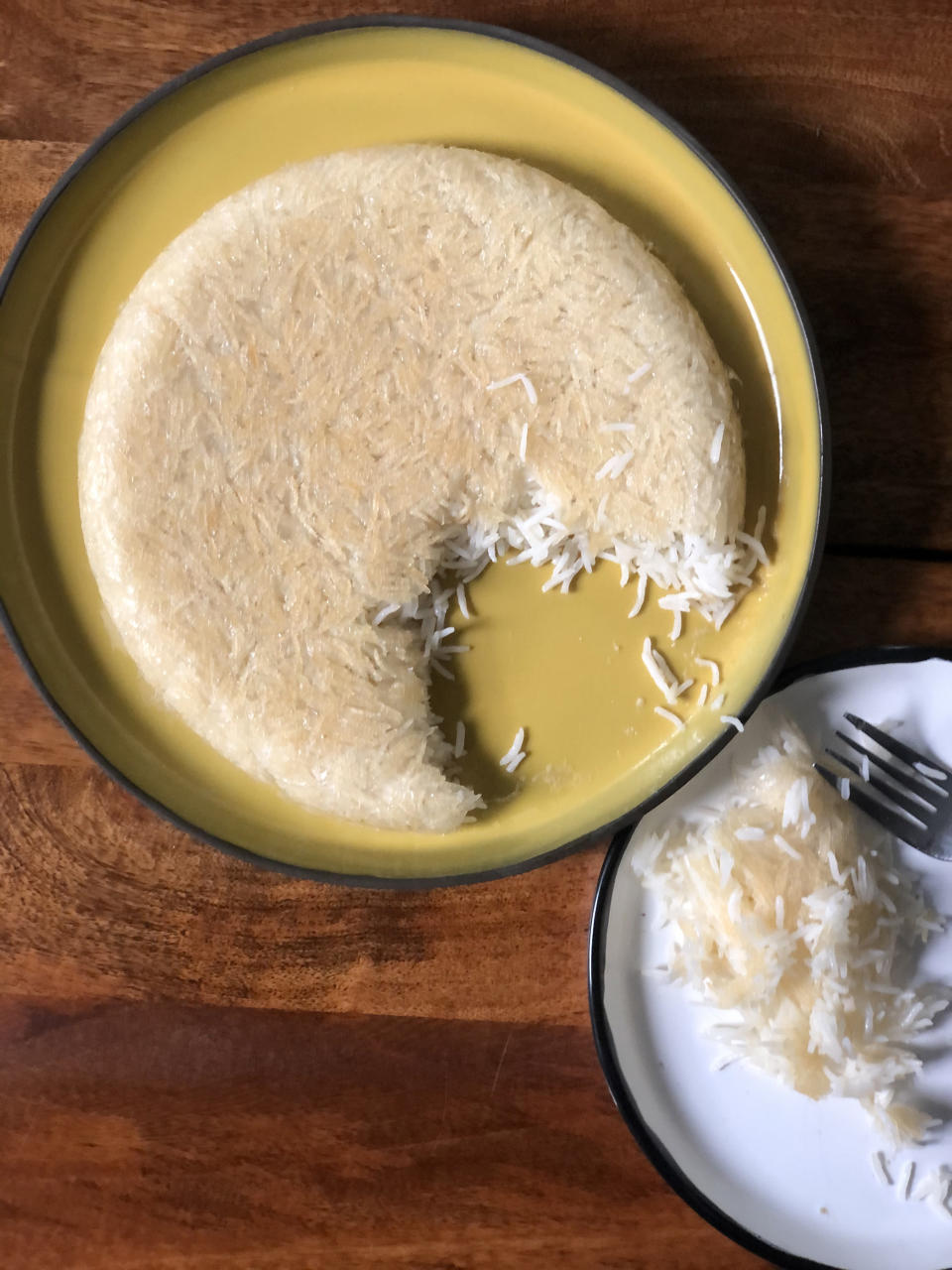
At that point, she might add a tablespoon or two of oil, and then she reduces the heat to very low and covers the pan with a kitchen towel, an Iranian technique that absorbs the condensation from the steam and helps the bottom of the rice crisp up. She leaves it here for 40 to 45 minutes. When it's done, she places a plate as large as the saucepan on top of it and flips it so the crispy bottom of the rice is on top, prying it loose with a spatula, if need be.
To get the "gorgeous orange hue," as Fahr described it, that tahdig is known for, you can add saffron to the rice. Place the strands in very hot water so it blooms, and then add that to the rice. You can also add salt to the rice.
Fahr said the strategy she shared is a "very basic, everyday" approach, but "you can definitely dress it up."
"I think it's more of a household thing," she continued. "There are very many variations of tahdig."
Puerto Rican Pegao
TODAY Food contributor Alejandra Ramos said she thinks of pegao, the Puerto Rican term for scorched rice, as "less a dish itself and rather a feature of another dish." One of the most traditional Puerto Rican dishes, arroz con gandules(rice with pigeon peas), lends itself nicely to pegao, which is a shortened version of "pegado," the Spanish word for "glued," and is sometimes written as "pega'o."
"It's something that we love similarly in the way that some people like pudding skin or the crunchy edges on a brownie," Ramos explained, adding that because she's not a big rice eater, she needs "that crispy part to really enjoy the rice."
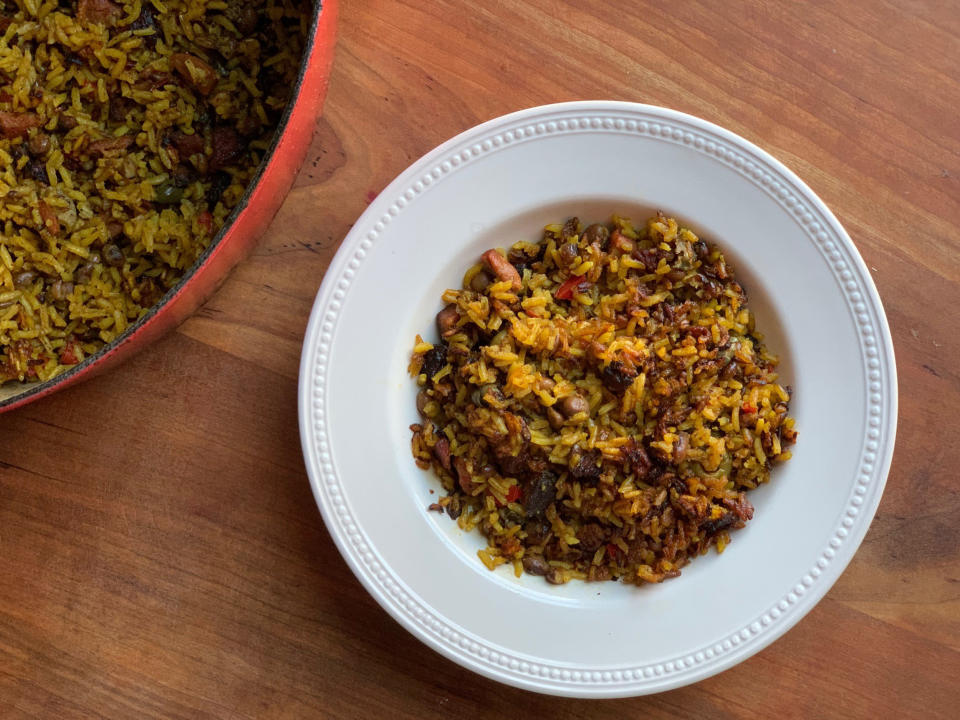
When aiming for pegao, she said it's important to use a pan that's big enough to avoid the rice actually burning. The rice shouldn't fill more than three-quarters of the pan. Instead of using just water, she said, in Puerto Rican dishes, it's usually cooked with other ingredients, such as peas, beans, chicken, pork, tomato sauce and aromatics, like onions and garlic.
Ramos also recommends using a cast-iron or stainless steel pan for extra "toastiness" in the crispy bits and "toasting" the rice in the pan by fully coating the grains it in a little bit of oil at the beginning of the recipe (along with the other initial ingredients).
While cooking the rice, you can stir the mixture but don't mess with the bottom too much, so it gets crispy. Leave it covered until most of the liquid is absorbed and uncover for the last few minutes. When it's done, Ramos said she typically serves the softer rice parts on top first and then scrapes up the pegao and serves that, too, but separately, in case of differing palates.
Ghanaian Kanzo
Fafa Gilbert, a Ghanian, London-based chef, said kanzo is typically made in a coal pot, which goes on top of hot coals until it boils and then is removed from direct heat. She added that, growing up, kanzo "wasn't a favorite of a lot of people."
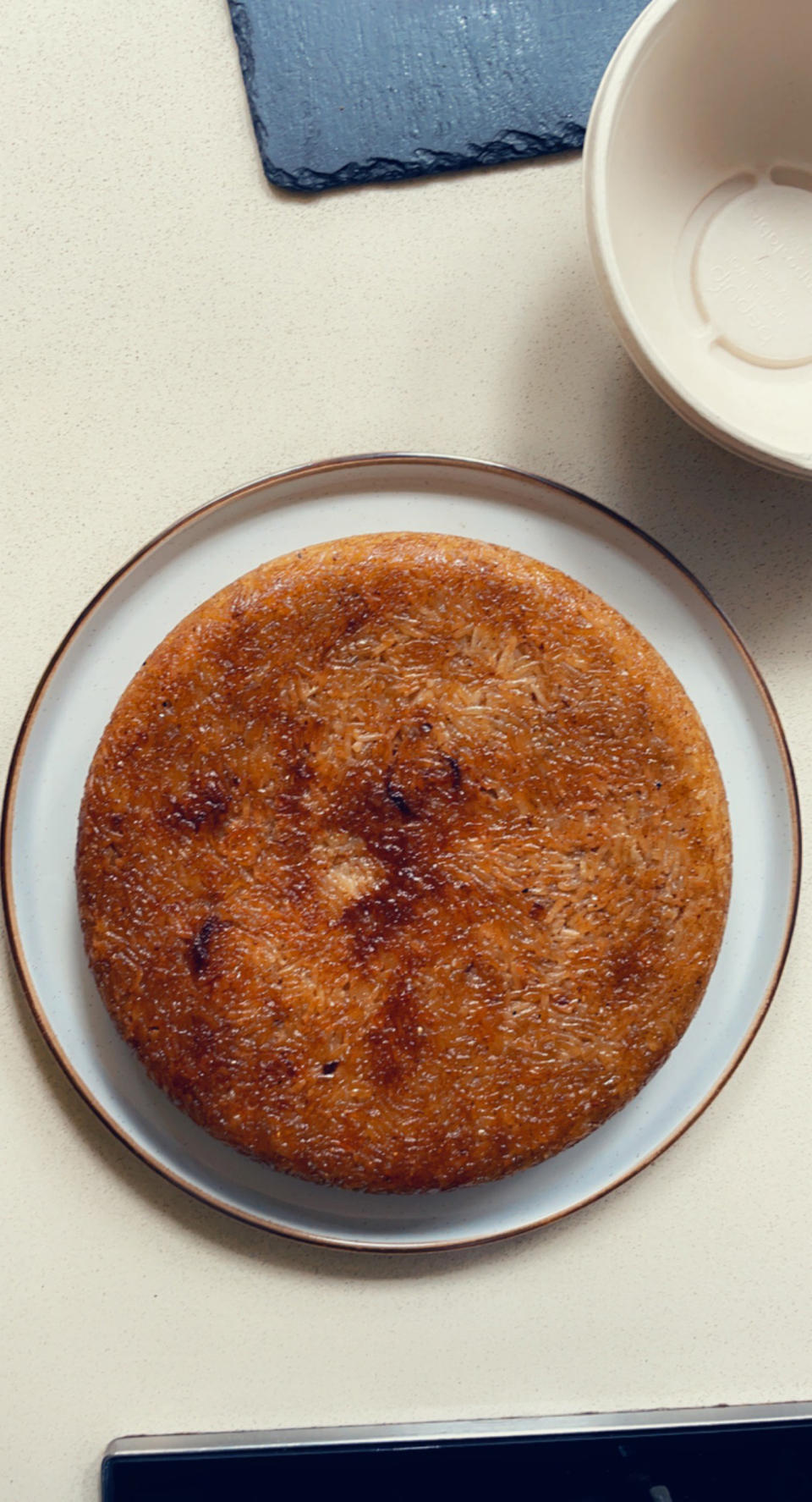
But now, she appreciates the dish so much that she created a recipe for jollof, a staple West African rice dish, with kanzo. To prepare it, she starts with a nonstick saucepan and prepares a dark-red, tomato-based stew. Once this is finished, she adds uncooked washed, rice and stir-fries it for about five minutes. Then she adds liquid, water or stock, and brings it to high heat until it starts to bubble.
Related: The real #FufuChallenge is not eating this glorious dish — it's making it.
Then she brings it to the lowest heat setting, covers it and doesn't touch it for 20 minutes. Next, she pours a little bit more liquid mixed with melted butter over the mixture, covers it again and leaves it for another 8 to 10 minutes. After that, she removes it from the heat but keeps it covered for 5 or 10 more minutes because trapping the steam can help remove the rice from the pan. Last, she turns the pan over onto a plate to serve the rice.
Her approach was, in part, inspired by her mom's jollof. "I would make sure I'd have my portion of the fluffy rice, but then my attention is to the bottom, and I'd just use my spoon to scrape the bottom of the saucepan," she recalled.
Korean Nurungji
Cooking teacher and writer Caroline Choe told TODAY thinks nurungji, the Korean term for scorched rice, is the "best part" of any rice dish, as it "has the most flavor." The most basic way to get nurungji, she said, is to boil rice at a high heat.

For two people, she rinses a cup of rice, puts it in a pot and covers it with water so it's a fingertip over the top of the rice. Then she brings it to a high heat for 10 minutes or so until most of the water evaporates and leaves it on for another 10 to 15 minutes, depending on "how blackened you want it."
But Choe doesn't often make nurungji on its own, she said. One of her go-to recipes that results in scorched rice features roast chicken. She puts rinsed rice on the bottom of a pot with some water, salt, pepper, onions, garlic and whatever other ingredients, and places the whole chicken on top to roast in the oven.
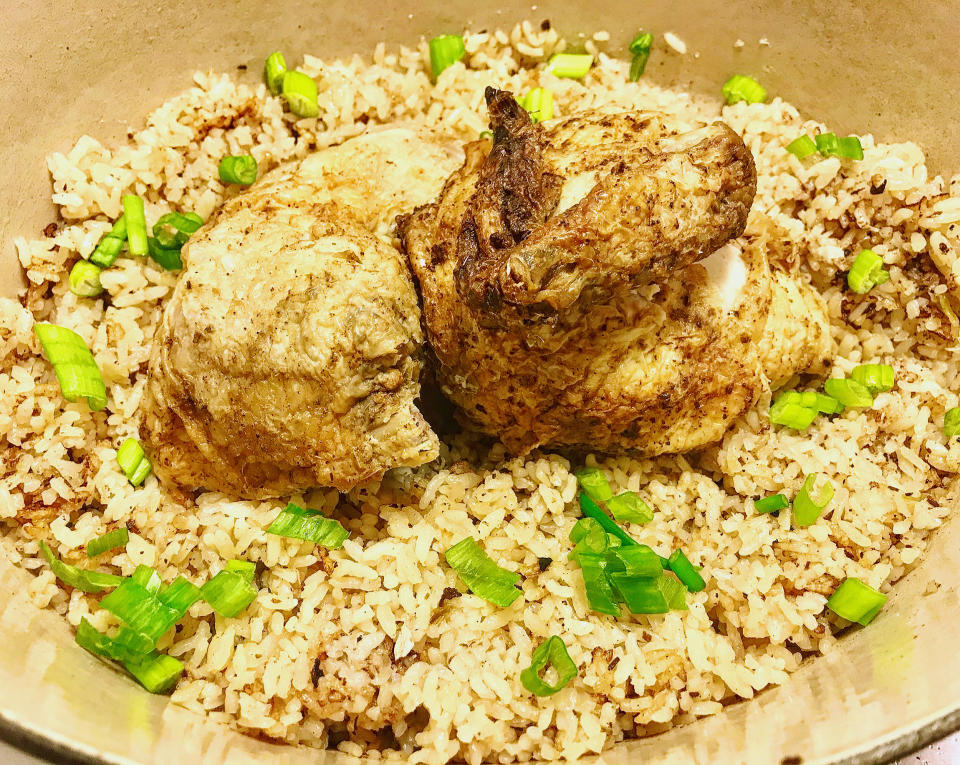
Another common Korean approach to scorched rice is to toast cooked, leftover rice in a pan. For more glutinous rices, you don't even need oil. If you toast both sides, this can result in something similar to a cracker, which is often eaten as a snack or with eggs, she said.
She added that her favorite way to consume nurungji is in tea, which her mom made all the time. The idea is instead of eating the rice, steep it in hot water and drink the mixture infused with its flavors. Choe also loves Noona's Ice Cream's Toasted Rice flavor.
Filipino Tutong
While many Filipinos don't eat scorched rice, Ponseca said, she does have some strategies for turning the bottom of rice into crispy, toasted goodness.
First, she recommends washing the rice four to five times to remove the starch. She also suggested soaking the rice with a little bit of seasoning, such as salt or pandan leaves, which have a similar flavor to vanilla extract. At her restaurant, the rice is usually cooked in a rice cooker with water and oil.
Ponseca also advised cooking the rice uncovered, or covered with a kitchen towel, to prevent the moisture from the steam recirculating throughout the rice. To remove the crispy bits from the bottom of the rice cooker, she said to add a little water or oil and water to help scrape it up, as you might with any number of pan sauces. Take care not to use so much that it loses its crispness.
Another strategy is to just cook up sinangag, a Filipino garlic fried rice dish. You simply fry old, cooked rice in a pan with a little extra oil and a little longer than usual to help it crisp up. Ponseca also likes to make tutong with arroz caldo, a type of Filipino congee, aka lugaw.
"It's a different texture than the softened, glutinous rice, the garlic and the ginger. It's really delightful," she said.
Chinese Guoba
Cookbook author and illustrator Liv Wan told TODAY via email that her first memory of guoba, the Chinese term for scorched rice, was in a restaurant in Taipei with her grandfather. She said she remembers seeing "a big plate of crispy rice thing" and being perplexed until the waiter returned with a pot of steaming shrimp sauce and poured it over the rice.
"The moment the sauce touched the guoba, a loud sizzling sound came out and it was absolutely eye-opening to me!" she recalled.
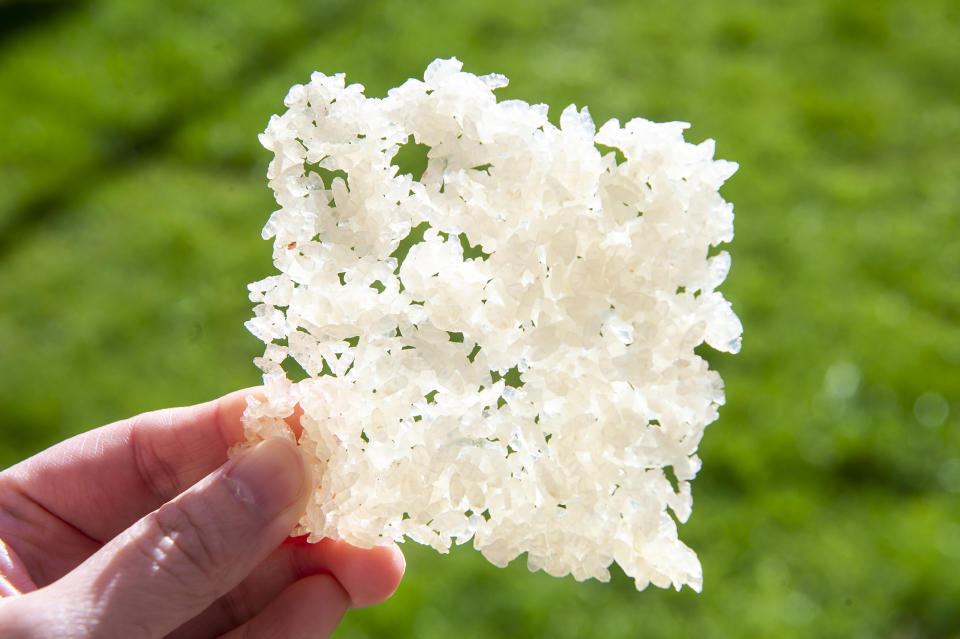
Wan shared her recipe for guoba with shrimp sauce and some tips for perfecting the dish. She rinses the rice three times before cooking the rice in a rice cooker with a one-to-one ratio. She also uses Taiwan Chishang rice, but says any other Chinese, Japanese or Korean rice will do.
She leaves the cooked rice in the fridge overnight. Then she cuts the rice into slices, places it on a baking sheet, sprinkles salt on it and spreads it all out with a spoon. She then bakes it in the oven for an hour, cuts it into portions, flips them and bakes them for another hour or so, until the rice is fully dehydrated.
Guoba with Shrimp Sauce by Liv Wan
If you like, she said, you can then fry the guoba pieces in hot oil so that they crisp up even more. This step is also what creates the popping sound that Wan so fondly remembers when the sauce is added. The baking sheet with rice (before it goes in the oven) can be stored in the fridge, and you can prepare smaller portions of guoba just by frying it.
"You can also eat guoba without any sauce and just treat it like a snack or rice crisps," Wan added.

